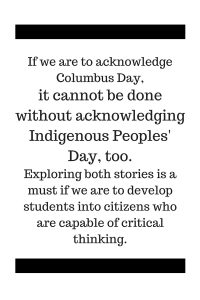Next Monday is Columbus Day, but in recent years, there’s been a movement to abolish Columbus Day and replace it with Indigenous Peoples’ Day. Columbus Day occupies a dubious spot in our nation’s calendar, ostensibly commemorating both the “discovery” of the Americas by Christopher Columbus and the subsequent destruction and enslavement of countless indigenous people. Today we’re pleased to share this guest post from educator and writer Tami Charles on rethinking how we acknowledge Columbus Day.
As children, we probably have all commemorated Columbus Day by singing the popular rhyme:
In fourteen hundred ninety-two,
Columbus sailed the ocean blue.
He had three ships and left from Spain.
He sailed through sunshine, wind, and rain.
Singing this song typically initiated elementary lessons on Christopher Columbus and his “discovery” of the Americas. This was sometimes followed by a coloring activity of the three ships: the Niña, Pinta, and Santa Maria, which often led to decorating feathered headbands as a symbol of the friendship between Columbus and the Native Americans he encountered on his voyages. This whitewashed version of history often overshadows the brutal truth: Christopher Columbus led numerous devastating movements against Indigenous peoples. Additionally, his voyages played a large part in the growth of the transatlantic slave trade.
Teachers of students in the lower grades may or may not touch upon such controversial topics when discussing this famous segment of American history. But how exactly is Columbus’s legacy addressed in middle and high schools today? Are schools inclined to teach from both the Anglo-American and the Indigenous viewpoints?
American Indian activist Winona LaDuke notably stated in Conquest: Sexual Violence and American Indian Genocide, “Movements for change, movements to make us well, to create healthy societies—whether tribal or American—are grounded in healing, are grounded in honesty.”
As such, it is imperative for educators to teach from a place of truth, be it easy or uncomfortable. The truth is that while Columbus was known for his expert navigational skills in travelling to the New World, the indigenous people suffered at the hands of this exploration.
 Upon first encountering the native people of the Americas, on October 12, 1492, Christopher wrote the following in his journal: “They should be good servants . . . . I, our Lord being pleased, will take hence, at the time of my departure, six natives for your Highnesses.” Columbus lived up to his promise, eventually capturing six natives and parading them around the streets of Spain. On October 14, 1492, Columbus also wrote, “with fifty men they can all be subjugated and made to do what is required of them.” It is clear that Columbus had domination in mind, and he proved this after his second voyage, when he captured 1,200 native people to be sold as slaves in Spain. The rest, as they say, is history. As Columbus claimed land for Spain, the freedom and lives of the indigenous people were taken as well.
Upon first encountering the native people of the Americas, on October 12, 1492, Christopher wrote the following in his journal: “They should be good servants . . . . I, our Lord being pleased, will take hence, at the time of my departure, six natives for your Highnesses.” Columbus lived up to his promise, eventually capturing six natives and parading them around the streets of Spain. On October 14, 1492, Columbus also wrote, “with fifty men they can all be subjugated and made to do what is required of them.” It is clear that Columbus had domination in mind, and he proved this after his second voyage, when he captured 1,200 native people to be sold as slaves in Spain. The rest, as they say, is history. As Columbus claimed land for Spain, the freedom and lives of the indigenous people were taken as well.
A culturally reflective teacher will expose students to literature that speaks to both sides of this history and allow them to develop their own hypotheses.
If we are to acknowledge Columbus Day, it cannot be done without acknowledging Indigenous People’s Day, too. Exploring both stories is a must if we are to develop students into citizens who are capable of critical thinking. We can begin by evaluating the following trusted links to resources, lesson plans, and articles:
Considerations for Inclusive Holidays and Observances
Columbus Day or Indigenous Peoples Day?
Teaching about Columbus Day: Mythbusters
Middle and high school students typically have the prior knowledge of Columbus’s famous expeditions, dating back to lessons taught in elementary school. Yet, according to an ongoing survey by the Cooperative Children’s Book Center, Native Americans are among the least represented groups in children’s and young adult literature. For these reasons, there is a heightened need to bring in rich texts that reflect Native voices to stand alongside the mono-cultural, Eurocentric texts that are prevalent in many classroom libraries today.
 Consequently, Hammer of Witches by Shana Mlawski is the type of novel that could spark deep conversation about this very subject. Hammer of Witches is a historical fantasy layered in rich cultural references dating back to the Columbus expedition era. After witnessing the murder of his uncle and aunt, young Baltasar Infante sets out to find his father, but unexpectedly finds himself travelling west with Cristóbal Colón, historically known as Christopher Columbus. Throughout the novel, a prophecy looms that a dark force will journey west and destroy the New World. (Hmmm, we wonder who that can be?)
Consequently, Hammer of Witches by Shana Mlawski is the type of novel that could spark deep conversation about this very subject. Hammer of Witches is a historical fantasy layered in rich cultural references dating back to the Columbus expedition era. After witnessing the murder of his uncle and aunt, young Baltasar Infante sets out to find his father, but unexpectedly finds himself travelling west with Cristóbal Colón, historically known as Christopher Columbus. Throughout the novel, a prophecy looms that a dark force will journey west and destroy the New World. (Hmmm, we wonder who that can be?)
Filled with magic and Old World tales, the novel itself challenges the meaning of “history,” in that one story can have multiple interpretations. The reader isn’t swayed to believe that Christopher Columbus destroyed an ancient civilization. On the contrary, readers are also not forced to think that the Indigenous people willingly surrendered their land to a complete stranger. It is here, on this level of objective reflection, where the novel shines! In turn, these are the exact ideals teachers should impart upon their students when discussing the upcoming holidays.
Using this novel as an anchor text, here are some learning activities teachers can use to add to the conversation of Columbus Day and Indigenous People’s Day. Each can be scaffolded to align with the Common Core State Standards for grades six through twelve:
- Using a graphic organizer, identify the religious and ethnic conflicts presented in the text. Present your findings to the class in the form of a team debate. Highlight any similarities or differences between the conflicts of the past and the conflicts of today. (Common Core State Standard.ELA-LITERACY.RL.9-10.6)
- Compare and contrast—Use a Venn Diagram to identify key components of the story of Christopher Columbus as it’s presented in more juvenile texts, versus what you’ve learned from Hammer of Witches. Be sure to identify similarities, if any are noted. Present your findings to the class. (Common Core State Standard.ELA-LITERACY.RH.9-10.9)
- Citing text evidence, analyze the overarching theme of the novel Hammer of Witches. Create a Power Point presentation to visually reflect how this theme is developed over the course of the text. (Common Core State Standard.ELA-LITERACY.RL.9-10.2)
- State your case! Research primary and secondary resources to justify whether schools should acknowledge Columbus Day or Indigenous People’s Day (or both). Present your case before a mock panel of school board members. (Common Core State Standard.ELA-LITERACY.RH.9-10.9)
Interested in more books that highlight indigenous voices and the power of story? Take a look at some of our recommendations below:
- Under the Mesquite by Guadalupe Garcia McCall: When the matriarch of a close-knit Mexican American family falls ill, Lupita must find a way to navigate through the pain and keep her family afloat.
- Killer of Enemies by Joseph Bruchac: Lozen is a seventeen-year-old Apache hunter with one mission in life: to kill the genetically engineered monsters that threaten human life.
- Summer of the Mariposas by Guadalupe Garcia McCall: A retelling of The Odyssey in which five sisters must fight evil on their journey home from Mexico.
- Trail of the Dead by Joseph Bruchac: The second installment of Killer of Enemies, in which Lozen must find refuge for her family from the despotic Ones. Little does she know, new monsters and secrets await her in this new world.
- Shame the Stars by Guadalupe Garcia McCall: A reimagined tale of Romeo and Juliet, set against the backdrop of the Mexican Revolution.
*Guadalupe Garcia McCall identifies as Mexican American. We have included her books here as an acknowledgement of indigenous Mexican voices, as children’s literature scholar Debbie Reese notes here.
You can also browse our Indigenous People’s Day/Columbus Day YA Collection by clicking here.
Teaching our children about the power of story is not a responsibility that lies solely in the hands of the educator. At home, parents can create discussion and spark critical reflection, too. In these pivotal moments, we can all celebrate the undying spirit of indigenous people, who in the face of oppression, have continually risen above to keep their cultures, their honor, and their stories alive. So, how will you acknowledge Columbus Day and Indigenous People’s Day? Let us know in the comments below!
Sources:
Hanke, Lewis (1949). The Spanish struggle for justice in the conquest of America. Philadelphia, PA: University of Pennsylvania Press.
https://ccbc.education.wisc.edu/books/pcstats.asp
Columbus’s journal: https://archive.org/details/cihm_05312 (see pages 38-41.)
Nguyen, Tram (2009). Language is a Place of Struggle: Great Quotes by People of Color. Boston, MA: Beacon Press. (p. 174.)
 For fourteen years, Tami Charles served as a public school educator but now writes full time. Her middle grade novel, Like Vanessa, debuts with Charlesbridge in spring, 2018. She is represented by Lara Perkins of the Andrea Brown Literary Agency.
For fourteen years, Tami Charles served as a public school educator but now writes full time. Her middle grade novel, Like Vanessa, debuts with Charlesbridge in spring, 2018. She is represented by Lara Perkins of the Andrea Brown Literary Agency.








